


Dense smoke from ammonia and bromine
Ammonia and bromine react vigorously and with production of intensely dense smoke. The reaction of liquid bromine with a solution of ammonia in water is very violent, but the reaction between bromine vapor and gaseous ammonia is even more spectacular. This reaction is accompanied with production of heat and huge amounts of dense white smoke.

 Bromine
vapor is very toxic and one must be really careful not to inhale this vapor. It
will lead to severe damage to the lungs and the respiratory tract. Bromine-water
is very corrosive. It will stain the skin and may lead to strong irritation of
the skin. Ammonia is irritating and one should try to avoid inhaling the gas.
The solution of ammonia in water is fairly strongly alkaline and it is bad for
the skin and particularly dangerous for the eyes.
Bromine
vapor is very toxic and one must be really careful not to inhale this vapor. It
will lead to severe damage to the lungs and the respiratory tract. Bromine-water
is very corrosive. It will stain the skin and may lead to strong irritation of
the skin. Ammonia is irritating and one should try to avoid inhaling the gas.
The solution of ammonia in water is fairly strongly alkaline and it is bad for
the skin and particularly dangerous for the eyes.
![]()
![]() Required
chemicals:
Required
chemicals:
-
bromine water, as concentrated as possible, such that it emits brown vapor of bromine
-
solution of ammonia in water, approximately 10% ammonia by weight
![]() Required
equipment:
Required
equipment:
-
glass beaker or erlenmeyer, approximately 100 ml size
- test tube
![]() Safety:
Safety:
-
bromine vapor is very toxic
-
bromine water is corrosive
- ammonia is irritating, the solution in water is corrosive
Remark: If only 5% household ammonia is available, then one can use that and add a small amount of solid sodium hydroxide to this. This expels some of the ammonia and then the 5% ammonia works equally well.
![]()
Procedure for performing the experiments
![]() Pour approximately 10 ml of ammonia solution in an erlenmeyer
or beaker.
Pour approximately 10 ml of ammonia solution in an erlenmeyer
or beaker.
![]() Pour approximately 2 ml of bromine water in a test tube and
shake a little, such that a nice amount of bromine vapor builds up in the test
tube.
Pour approximately 2 ml of bromine water in a test tube and
shake a little, such that a nice amount of bromine vapor builds up in the test
tube.
![]() Pour the bromine vapor into the erlenmeyer with the ammonia
vapor in it. Immediately, dense clouds of smoke are formed. Finally, pour in
some of the bromine water, along the glass of the erlenmeyer. This results in
formation of even more smoke.
Pour the bromine vapor into the erlenmeyer with the ammonia
vapor in it. Immediately, dense clouds of smoke are formed. Finally, pour in
some of the bromine water, along the glass of the erlenmeyer. This results in
formation of even more smoke.
Do this experiment in a very well ventilated room, or even better, in a fume hood, or outside on a day when there hardly is any wind.
![]()
Results of experiment
The pictures below show what happens if a test tube with bromine vapor is kept in the ammonia gas, given off by the ammonia solution. The left picture shows the result after pouring in just a small amount of bromine vapor. The right picture shows the result of adding a little bit more of bromine vapor. No liquid bromine water is poured into the erlenmeyer, just some bromine vapor. This nicely shows that the smoke is very dense.
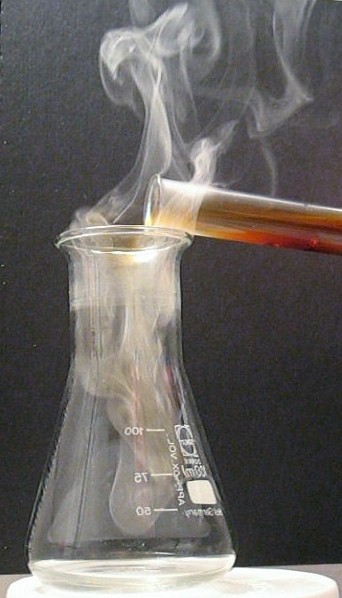
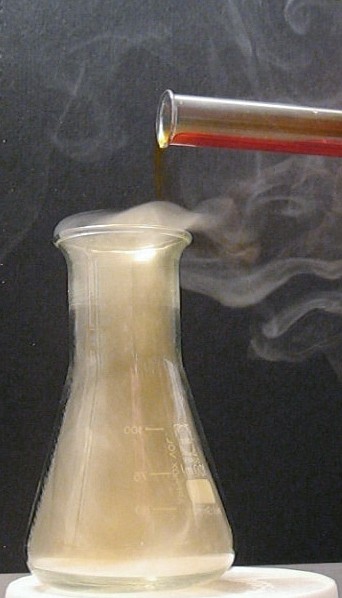
When some liquid is poured in, then the smoke becomes even more dense, and the air inside the erlenmeyer becomes totally opaque. The numbers on the erlenmeyer (100, 75 and 50 ml marks) cannot be seen anymore. Initially, the smoke seems to be brown, but one minute later, the smoke is perfectly white. The brown color is due to bromine vapor, which has not yet reacted with ammonia.
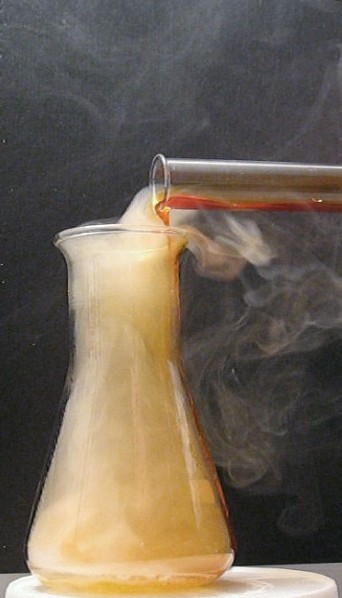
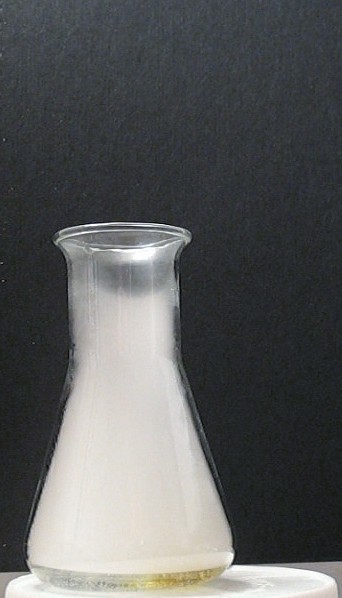
The air with smoke is quite dense and it only very slowly diffuses out of the erlenmeyer. It can be poured out and when most of the smoke is poured out, it can be put back, without the remaining smoke being mixed with air. This effect also is very neat. It is shown in the two pictures below.
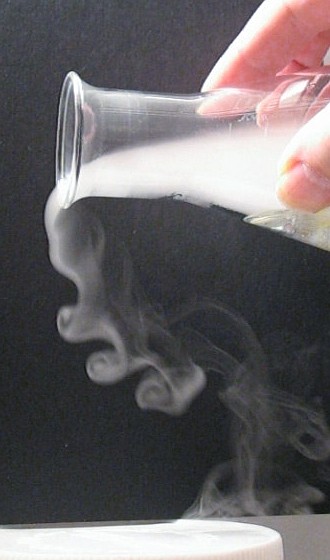
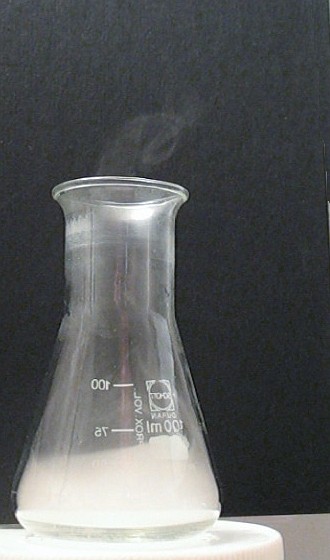
Two stunning videos are made of this reaction. The first video shows the making of the smoke by pouring bromine vapor and some bromine water into the erlenmeyer with ammonia, the second video shows the pouring of the smoke out of the erlenmeyer:
Beware, these video files are quite large. They have a size of approximately 2 MByte. Download time depends on your internet connection.
Surprisingly, when 25% ammonia is used, then the result is quite different. The liquid with 25% ammonia gives off much more ammonia gas than the 10% solution and this makes the air, mixed with the ammonia gas much lighter than plain air. The ammonia/air mix is moving upwards. This can be nicely seen, when bromine vapor is added to the air/ammonia mix from 25% ammonia. The density of the smoke and bromine do not compensate for the lower density of the ammonia gas and the net effect is that the smoke does not want to go into the erlenmeyer, but it moves upwards instead and is taken away by the air-flow, due to the ventilation system. A video is made of this, but beware, this video is really big, well over 4 MByte.
video of smoke, moving upwards
![]()
Discussion of results
The explanation for this reaction seems to be fairly simple. Bromine oxidizes ammonia easily. It only oxidizes ammonia, ammonium ion is not oxidized by bromine.
8NH3 + 3Br2 → 6NH4Br + N2
The compound NH4Br, ammonium bromide, is a white solid. This is the white smoke, produced in this experiment.
The precise mechanism for this reaction, however, is not simple at all. This reaction requires the presence of water vapor. Ultra dry bromine vapor and gaseous dry ammonia do not react. When some water is added, then the reaction sets in. The water is needed in one of the steps of the reaction mechanism.
The formation of nitrogen cannot be observed in this reaction, but when some bromine water is added to an excess amount of dilute ammonia, then one can easily see the bubbles of nitrogen gas.